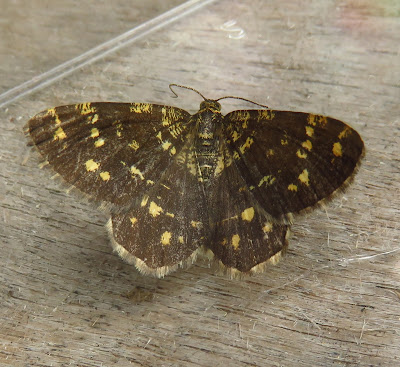After a pretty average mothing season at the country park, one or two scarce species have been dropping into the trap in recent nights. Star moth of the year was this nationally scarce Mocha moth, pictured above resting on the scruffy Perspex top of the Robinson moth-trap on the night of Monday 21st.
I believe this is the first mocha record for north-east Essex and it's currently only being found in a few woodlands in south Essex so it's a bit of a mystery where this individual may have originated from. The foodplant is field maple, of which there's quite a bit growing here at the park.
The moth is supposedly named after the semi-precious stone, the mocha stone, which has similar markings.
I believe this is the first mocha record for north-east Essex and it's currently only being found in a few woodlands in south Essex so it's a bit of a mystery where this individual may have originated from. The foodplant is field maple, of which there's quite a bit growing here at the park.
The moth is supposedly named after the semi-precious stone, the mocha stone, which has similar markings.
Another attractive moth found in the trap on Tuesday morning was this pink coloured vestal moth. A migrant moth which arrives from the continent in varying numbers each year. This is the first record since 2006 which is very surprising considering how the park on the coast is ideally located for immigrant moths. Admiring the bright pink diagonal stripe across each wing and the other pink patches too, makes the long wait for this scarce visitor all the more worthwhile.
There have been lots of latticed heath moths turning up at moth traps in parts of Essex and south Suffolk during the middle period of August. Over 150 were recorded at the trap on 11th August, while on the 21st, among the fifty or so usual chequered patterned form of latticed heaths was this striking dark form pictured above. This unusual form known as alboguttata which displays a number of pale spots, has not been seen here before.
Even the underside of the wings show the dark pattern but otherwise looks and flutters about just like the other latticed heaths.
The warm night on Monday 21st brought one or two other migrant moths including this dark swordgrass.
Although only about 33 species of macro moth were noted, there was a good showing of over 300 individuals in the trap. Lots of flounced rustics, setaceous Hebrew characters, latticed heaths, uncertains / rustics and vine's rustics.
Although only about 33 species of macro moth were noted, there was a good showing of over 300 individuals in the trap. Lots of flounced rustics, setaceous Hebrew characters, latticed heaths, uncertains / rustics and vine's rustics.
The large thorn seems has been thriving at the country park in recent years with the first two individuals for this year already appearing at the trap on Wednesday 23rd. More should be appearing into early September.
The dark-bordered pearl (Evergestis limbata), was another nationally scarce species at the park on the 23rd, the second record for the site after the first one four years ago. This is a rare migrant micro-moth in southern England.
Other migrant micro moths noted were several rush veneers and rusty dot pearls.
Other migrant micro moths noted were several rush veneers and rusty dot pearls.









No comments:
Post a Comment